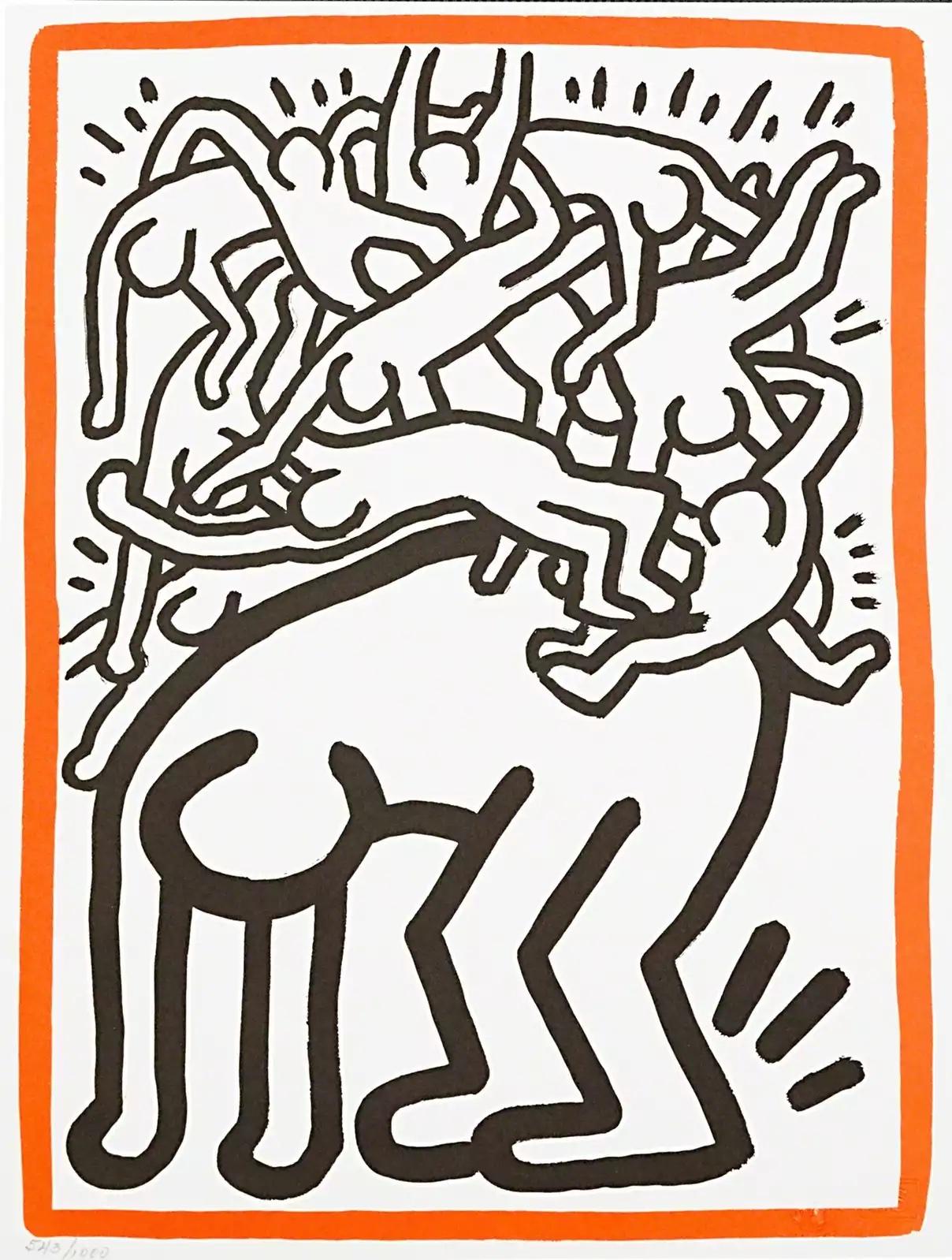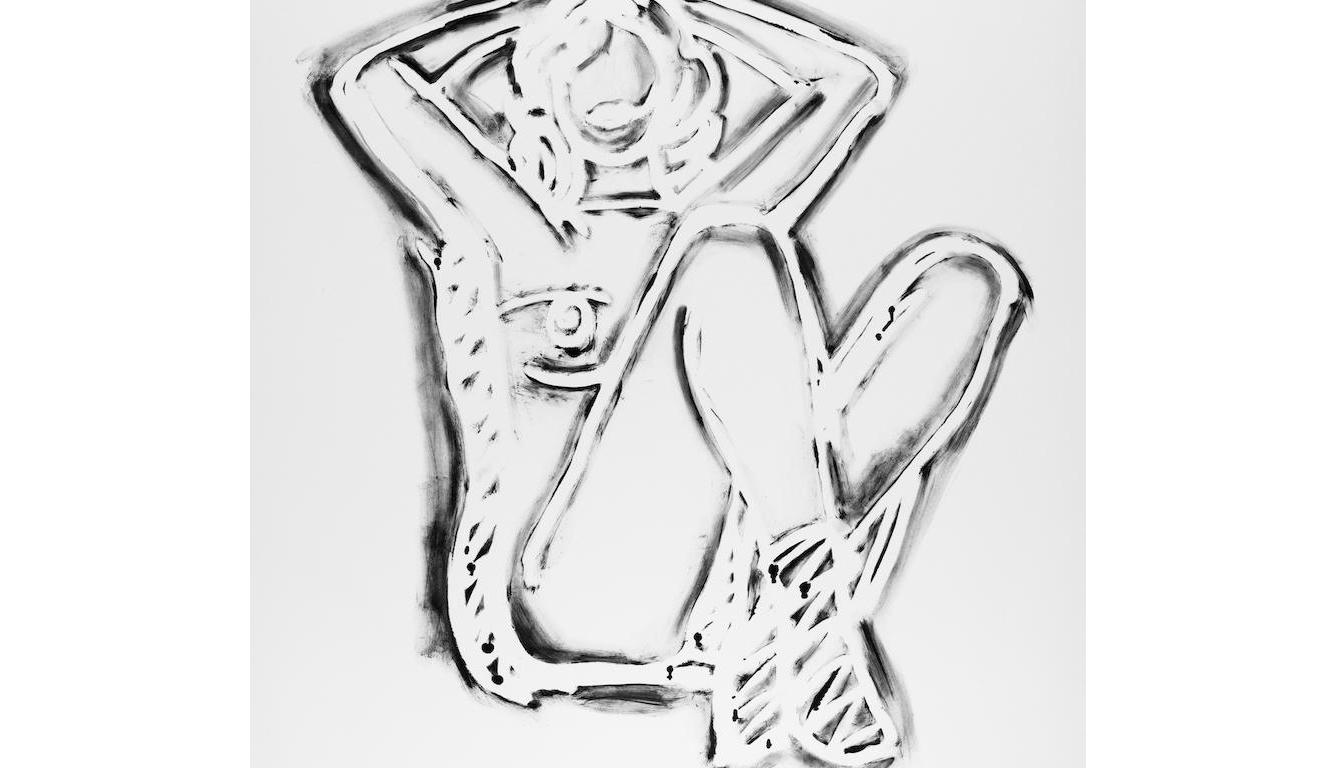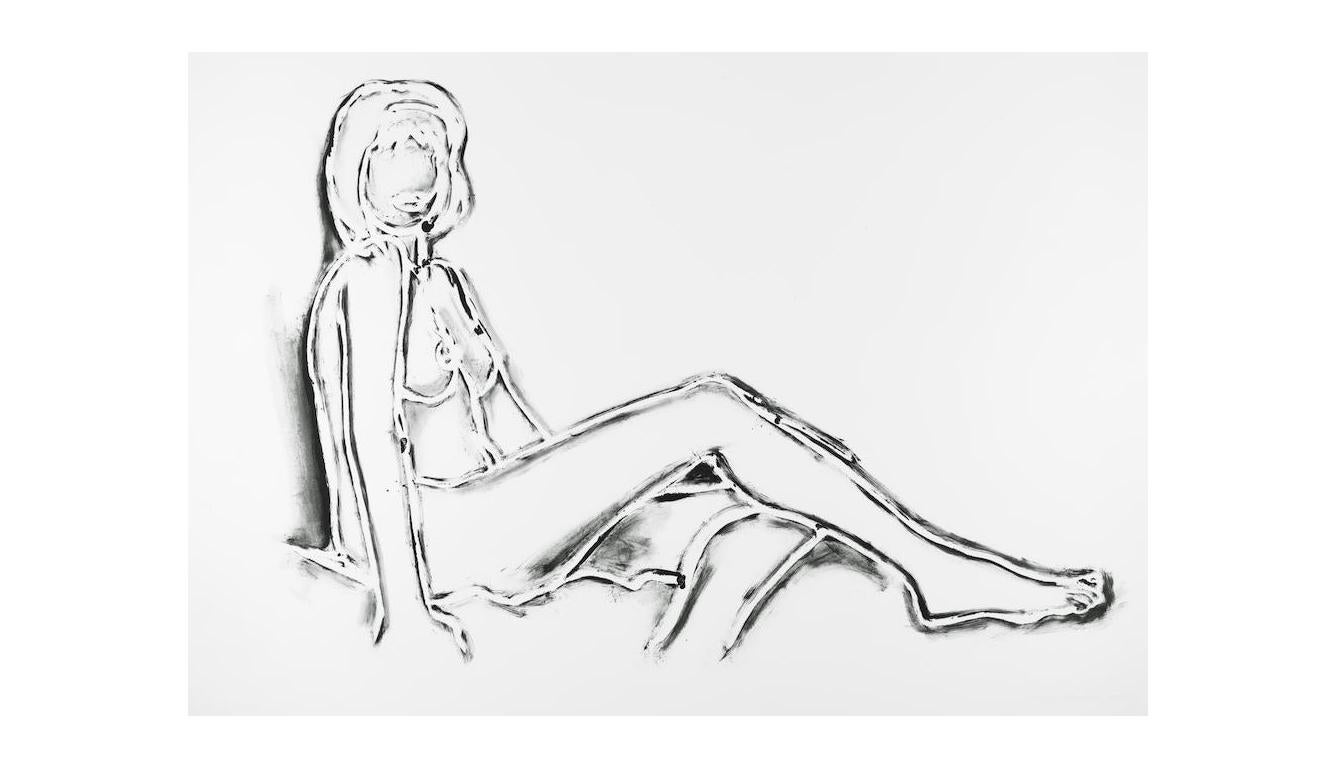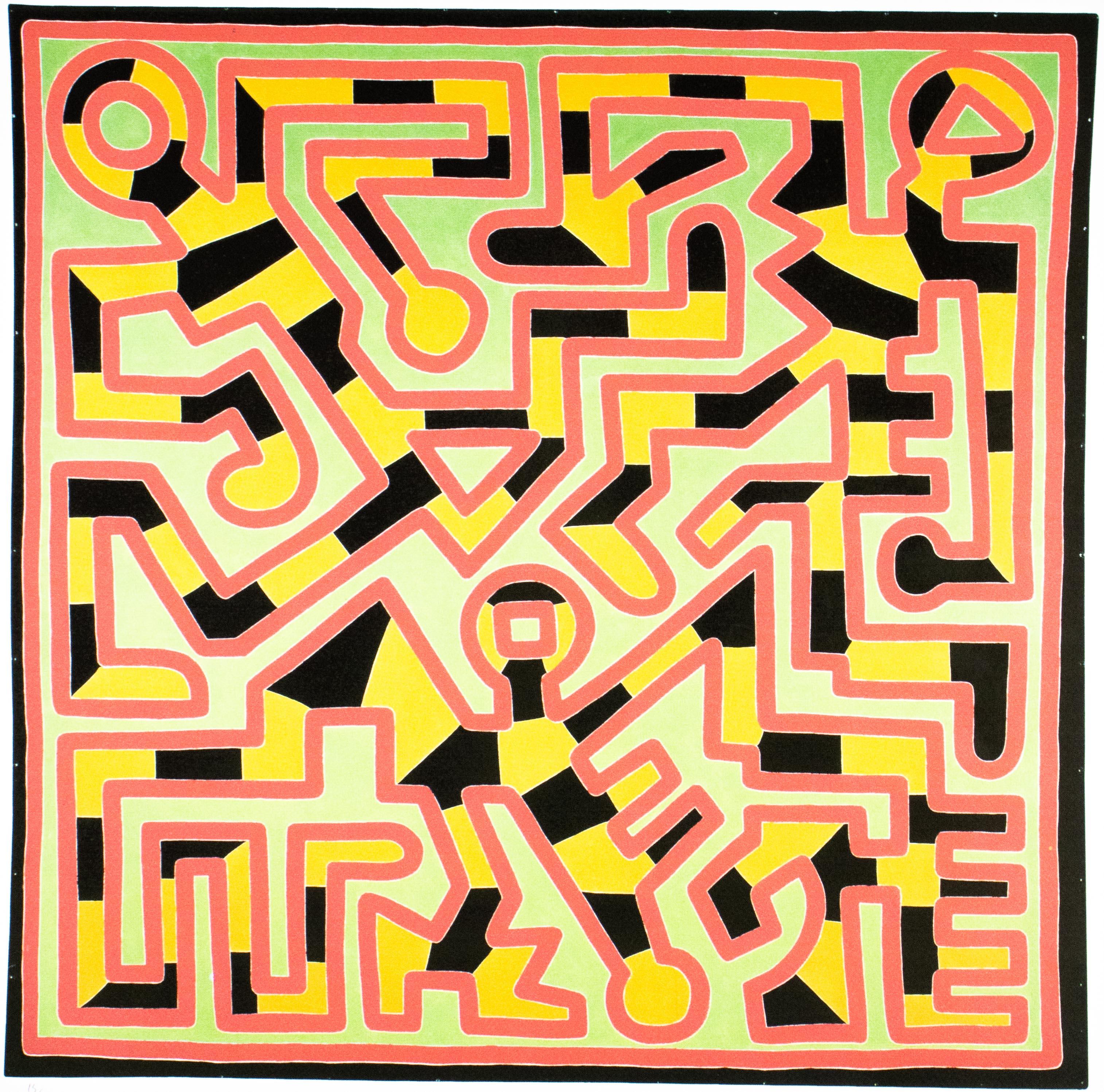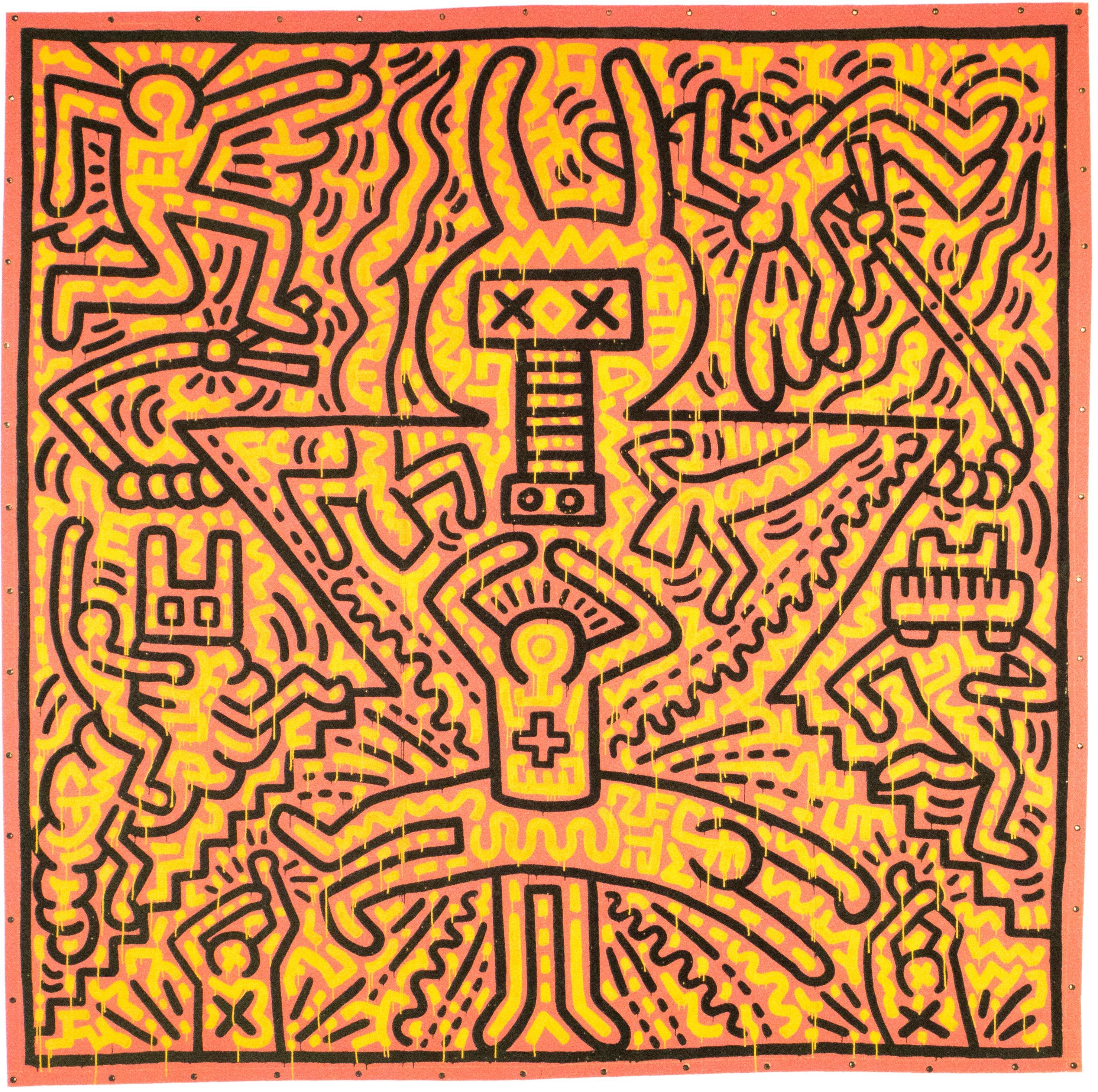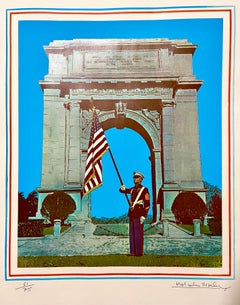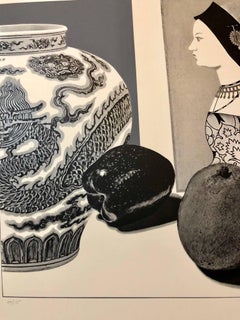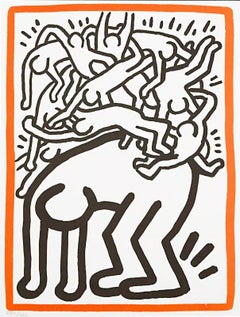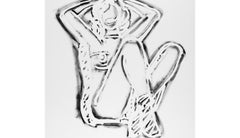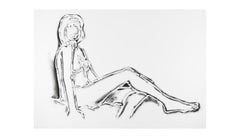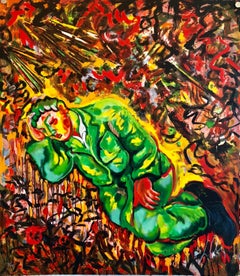
Large lithograph Italian Post Modernist Bright Figurative Pop Art Sleeping Man
View Similar Items
Want more images or videos?
Request additional images or videos from the seller
1 of 9
Sandro ChiaLarge lithograph Italian Post Modernist Bright Figurative Pop Art Sleeping Manc.1980-1990
c.1980-1990
About the Item
- Creator:Sandro Chia (1946, Italian)
- Creation Year:c.1980-1990
- Dimensions:Height: 29 in (73.66 cm)Width: 25.5 in (64.77 cm)
- Medium:
- Movement & Style:
- Period:
- Condition:
- Gallery Location:Surfside, FL
- Reference Number:1stDibs: LU3823475652
About the Seller
4.9
Platinum Seller
These expertly vetted sellers are 1stDibs' most experienced sellers and are rated highest by our customers.
Established in 1995
1stDibs seller since 2014
1,546 sales on 1stDibs
Typical response time: 1 hour
More From This SellerView All
- 1970 Silencio, Direccion Unica, One Way Spanish Political Etching Pop Art PrintBy Juan GenovesLocated in Surfside, FLJuan Genovés Candel (Spanish, 1930-) Painter, illustrator, and graphic printmaker engraver. He painted 'El abrazo' ('the embrace'), which became an emblematic poster during the Spanish political transition. He was born in Valencia in 1930. The son of Juan Genovés Cubells, an artisan whose family was close to the labor movement. His mother Maria Candel Muñoz came from a family of practicing Catholics. In 1946 Genovés studied at the Escuela de Bellas Artes de San Carlos in Valencia and then settled in Madrid. He set up the 'Los Siete' group together with other artists in 1949, and the following year he travelled to Madrid, where he was influenced by the works by Fra Angélico and Hieronymus Bosch in the Prado Museum. In 1957 he had his first solo exhibitions in the gallery Alfil, Madrid and in the Museo d'Arte Moderna, Havana. He is considered the most important representative of modern Spanish painting. His images, executed in a politically engaged, critical realism...Category
1970s Pop Art Figurative Prints
MaterialsLithograph
- Malcolm Morley 1969 Vintage British Pop Art Screenprint Lithograph Marine w FlagBy Malcolm MorleyLocated in Surfside, FLMalcolm Morley (British, b. 1931) Silkscreen screenprint Title: Marine Sergeant at Valley Forge Hand signed lower right. on BFK Rives paper. Provenance: Estate of Roger Prigent - Malmaison. (from Kornblee Gallery, photo of label but label is not included) Image: 19 1/4"H x 16" W; Sheet: 30 1/4"H x 22 1/2" W. Printer: Chiron Press (New York, NY) Date: 1969 Malcolm Morley (1931-2018) is an English artist now living in the United States. He is best known as a photorealist. Morley was born in north London. He had a troubled childhood—after his home was blown up by a bomb during the Blitz in World War II, his family was homeless for a time—and did not discover art until serving a three-year stint in Wormwood Scrubs prison. After release, he studied art first at the Camberwell School of Arts and then at the Royal College of Art (1955–1957), where his fellow students included Peter Blake and Frank Auerbach. In 1956, he saw an exhibition of contemporary American art at the Tate Gallery, and began to produce paintings in an abstract expressionist style. In the mid 1960s, Morley briefly taught at Ohio State University, and then moved back to New York City, where he taught at SUNY Stony Brook from 1970 through 1974 and the School of Visual Arts. In the early 1980s he was married to the Brazilian artist Marcia Grostein...Category
21st Century and Contemporary Pop Art Figurative Prints
MaterialsLithograph, Screen
- Still Life with Hans Maler Pop Art Serigraph Hand SignedBy Josef LeviLocated in Surfside, FLOn deckle edged watermarked Arches French paper. hand signed in pencil, dated and numbered. the edition size is 175. there are three states of the same image image each with increasing detail and color. This is just for the one in the photo. Josef Alan Levi (1938) is an American artist whose works range over a number of different styles, but which are unified by certain themes consistently present among them. Josef Levi began his artistic career in the 1960s and early '70s, producing highly abstract and very modernist pieces: these employing exotic materials such as light fixtures and metallic parts. By 1975, Levy had transitioned to painting and drawing still lifes. At first these were, traditionally, of mundane subjects. Later, he would depict images from art history, including figures originally created by the Old Masters. Around 1980, he made another important shift, this time toward creating highly precise, though subtly altered reproductions of pairs of female faces which were originally produced by other artists. It is perhaps this work for which he is most well known. Since around 2000, Josef Levi has changed the style of his work yet again: now he works entirely with computers, using digital techniques to abstract greatly from art history, and also from other sources. Levi's works of art in the collections of the Museum of Modern Art, NYC, the National Gallery of Art, and the Albright-Knox Museum, among many others. Levi's art has been featured on the cover of Harper's Magazine twice, once in June 1987, and once in May 1997. Josef Levi received a Bachelor of Arts degree in 1959 from the University of Connecticut, where he majored in fine arts and minored in literature. From 1959 to 1960, he served to a first lieutenant in the U.S. Army, and from 1960 through 1967 he was in the U.S. Army Reserves. In 1966, he received the Purchase Award from the University of Illinois in 1966, and he was featured in New Talent U.S.A. by Art in America. He was an artist in residence at Appalachian State University in 1969, taught at Farleigh Dickenson University in 1971 and was a visiting professor of art at Pennsylvania State University in 1977. From 1975 to 2007, Levi resided in New York City. He now lives in an apartment in Rome, where he is able to paint with natural light as he was unable in New York. From 1959 to 1960, Josef took some courses of Howard McParlin Davis and Meyer Schapiro at Columbia University which initiated him into the techniques of reproducing the works of the Old Masters. His first works, created in the 1960s, were wood and stone sculptures of women. His first mature works were abstract pieces, constructed of electric lights and steel. In 1970, Levi's materials included fluorescent light bulbs, Rust-Oleum and perforated metal in addition to paint and canvas. By 1980, Josef Levi's art had transformed into a very specific form: a combination of reproductions of female faces which were originally depicted by other artists. The faces which he reproduces may be derived from either portraits or from small portions of much larger works; they are taken from paintings of the Old Masters, Japanese ukiyo-e, and 20th-century art. Artists from whom he has borrowed include: Vermeer, Rembrandt, Piero della Francesca, Botero, Matisse, Utamaro, Correggio, Da Vinci, Picasso, Chuck Close, Max Beckmann, Pisanello, Lichtenstein. The creation of these works is informed by Levi's knowledge and study of art history. Josef Levi's paintings from this period are drawn, then painted on fine linen canvas on wooden stretchers. The canvas is coated with twenty-five layers of gesso in order to produce a smooth surface on which to work. The drawing phase takes at least one month. Levi seals the drawing with acrylic varnish, and then he may apply layers of transparent acrylic in order to approximate the look of old paintings. After the last paint is applied, another layer of acrylic varnish is sprayed on to protect the work. Most of the figures in his contemporary pieces are not paired with any others. SELECTED COLLECTIONS MUSEUM OF MODERN ART, NEW YORK, NY ALBRIGHT- KNOX GALLERY, BUFFALO, NY ALDRICH MUSEUM OF CONTEMPORARY ART, RIDGEFIELD, CT NATIONAL GALLERY OF ART, WASHINGTON, DC BROOKLYN MUSEUM OF ART, BROOKLYN, NY SMITHSONIAN NATIONAL MUSEUM OF AMERICAN HISTORY, WASHINGTON, DC CORCORAN GALLERY, WASHINGTON, DC UNIVERSITY OF NOTRE DAME ART...Category
1970s Pop Art Figurative Prints
MaterialsLithograph, Screen
- Still Life with Hans Maler Pop Art Serigraph Hand SignedBy Josef LeviLocated in Surfside, FLOn deckle edged watermarked Arches French paper. hand signed in pencil, dated and numbered. the edition size is 175. there are three states of the same image image each with increasing detail and color. This is just for the one in the photo. Josef Alan Levi (1938) is an American artist whose works range over a number of different styles, but which are unified by certain themes consistently present among them. Josef Levi began his artistic career in the 1960s and early '70s, producing highly abstract and very modernist pieces: these employing exotic materials such as light fixtures and metallic parts. By 1975, Levy had transitioned to painting and drawing still lifes. At first these were, traditionally, of mundane subjects. Later, he would depict images from art history, including figures originally created by the Old Masters. Around 1980, he made another important shift, this time toward creating highly precise, though subtly altered reproductions of pairs of female faces which were originally produced by other artists. It is perhaps this work for which he is most well known. Since around 2000, Josef Levi has changed the style of his work yet again: now he works entirely with computers, using digital techniques to abstract greatly from art history, and also from other sources. Levi's works of art in the collections of the Museum of Modern Art, NYC, the National Gallery of Art, and the Albright-Knox Museum, among many others. Levi's art has been featured on the cover of Harper's Magazine twice, once in June 1987, and once in May 1997. Josef Levi received a Bachelor of Arts degree in 1959 from the University of Connecticut, where he majored in fine arts and minored in literature. From 1959 to 1960, he served to a first lieutenant in the U.S. Army, and from 1960 through 1967 he was in the U.S. Army Reserves. In 1966, he received the Purchase Award from the University of Illinois in 1966, and he was featured in New Talent U.S.A. by Art in America. He was an artist in residence at Appalachian State University in 1969, taught at Farleigh Dickenson University in 1971 and was a visiting professor of art at Pennsylvania State University in 1977. From 1975 to 2007, Levi resided in New York City. He now lives in an apartment in Rome, where he is able to paint with natural light as he was unable in New York. From 1959 to 1960, Josef took some courses of Howard McParlin Davis and Meyer Schapiro at Columbia University which initiated him into the techniques of reproducing the works of the Old Masters. His first works, created in the 1960s, were wood and stone sculptures of women. His first mature works were abstract pieces, constructed of electric lights and steel. In 1970, Levi's materials included fluorescent light bulbs, Rust-Oleum and perforated metal in addition to paint and canvas. By 1980, Josef Levi's art had transformed into a very specific form: a combination of reproductions of female faces which were originally depicted by other artists. The faces which he reproduces may be derived from either portraits or from small portions of much larger works; they are taken from paintings of the Old Masters, Japanese ukiyo-e, and 20th-century art. Artists from whom he has borrowed include: Vermeer, Rembrandt, Piero della Francesca, Botero, Matisse, Utamaro, Correggio, Da Vinci, Picasso, Chuck Close, Max Beckmann, Pisanello, Lichtenstein. The creation of these works is informed by Levi's knowledge and study of art history. Josef Levi's paintings from this period are drawn, then painted on fine linen canvas on wooden stretchers. The canvas is coated with twenty-five layers of gesso in order to produce a smooth surface on which to work. The drawing phase takes at least one month. Levi seals the drawing with acrylic varnish, and then he may apply layers of transparent acrylic in order to approximate the look of old paintings. After the last paint is applied, another layer of acrylic varnish is sprayed on to protect the work. Most of the figures in his contemporary pieces are not paired with any others. SELECTED COLLECTIONS MUSEUM OF MODERN ART, NEW YORK, NY ALBRIGHT- KNOX GALLERY, BUFFALO, NY ALDRICH MUSEUM OF CONTEMPORARY ART, RIDGEFIELD, CT NATIONAL GALLERY OF ART, WASHINGTON, DC BROOKLYN MUSEUM OF ART, BROOKLYN, NY SMITHSONIAN NATIONAL MUSEUM OF AMERICAN HISTORY, WASHINGTON, DC CORCORAN GALLERY, WASHINGTON, DC UNIVERSITY OF NOTRE DAME ART...Category
1970s Pop Art Figurative Prints
MaterialsLithograph, Screen
- Still Life with German Master Pop Art Serigraph Hand SignedBy Josef LeviLocated in Surfside, FLOn deckle edged watermarked Arches French paper with publishers embossed blindstamp. hand signed in pencil, dated and numbered. the edition size is 175. there are three states of the same image image each with increasing detail and color. This auction is just for the one shown in the photos. Josef Alan Levi (1938) is an American artist whose works range over a number of different styles, but which are unified by certain themes consistently present among them. Josef Levi began his artistic career in the 1960s and early '70s, producing highly abstract and very modernist pieces: these employing exotic materials such as light fixtures and metallic parts. By 1975, Levy had transitioned to painting and drawing still lifes. At first these were, traditionally, of mundane subjects. Later, he would depict images from art history, including figures originally created by the Old Masters. Around 1980, he made another important shift, this time toward creating highly precise, though subtly altered reproductions of pairs of female faces which were originally produced by other artists. It is perhaps this work for which he is most well known. Since around 2000, Josef Levi has changed the style of his work yet again: now he works entirely with computers, using digital techniques to abstract greatly from art history, and also from other sources. Levi's works of art in the collections of the Museum of Modern Art, NYC, the National Gallery of Art, and the Albright-Knox Museum, among many others. Levi's art has been featured on the cover of Harper's Magazine twice, once in June 1987, and once in May 1997. Josef Levi received a Bachelor of Arts degree in 1959 from the University of Connecticut, where he majored in fine arts and minored in literature. From 1959 to 1960, he served to a first lieutenant in the U.S. Army, and from 1960 through 1967 he was in the U.S. Army Reserves. In 1966, he received the Purchase Award from the University of Illinois in 1966, and he was featured in New Talent U.S.A. by Art in America. He was an artist in residence at Appalachian State University in 1969, taught at Farleigh Dickenson University in 1971 and was a visiting professor of art at Pennsylvania State University in 1977. From 1975 to 2007, Levi resided in New York City. He now lives in an apartment in Rome, where he is able to paint with natural light as he was unable in New York. From 1959 to 1960, Josef took some courses of Howard McParlin Davis and Meyer Schapiro at Columbia University which initiated him into the techniques of reproducing the works of the Old Masters. His first works, created in the 1960s, were wood and stone sculptures of women. His first mature works were abstract pieces, constructed of electric lights and steel. In 1970, Levi's materials included fluorescent light bulbs, Rust-Oleum and perforated metal in addition to paint and canvas. By 1980, Josef Levi's art had transformed into a very specific form: a combination of reproductions of female faces which were originally depicted by other artists. The faces which he reproduces may be derived from either portraits or from small portions of much larger works; they are taken from paintings of the Old Masters, Japanese ukiyo-e, and 20th-century art. Artists from whom he has borrowed include: Vermeer, Rembrandt, Piero della Francesca, Botero, Matisse, Utamaro, Correggio, Da Vinci, Picasso, Chuck Close, Max Beckmann, Pisanello, Lichtenstein. The creation of these works is informed by Levi's knowledge and study of art history. Josef Levi's paintings from this period are drawn, then painted on fine linen canvas on wooden stretchers. The canvas is coated with twenty-five layers of gesso in order to produce a smooth surface on which to work. The drawing phase takes at least one month. Levi seals the drawing with acrylic varnish, and then he may apply layers of transparent acrylic in order to approximate the look of old paintings. After the last paint is applied, another layer of acrylic varnish is sprayed on to protect the work. Most of the figures in his contemporary pieces are not paired with any others. SELECTED COLLECTIONS MUSEUM OF MODERN ART, NEW YORK, NY ALBRIGHT- KNOX GALLERY, BUFFALO, NY ALDRICH MUSEUM OF CONTEMPORARY ART, RIDGEFIELD, CT NATIONAL GALLERY OF ART, WASHINGTON, DC BROOKLYN MUSEUM OF ART, BROOKLYN, NY SMITHSONIAN NATIONAL MUSEUM OF AMERICAN HISTORY, WASHINGTON, DC CORCORAN GALLERY, WASHINGTON, DC UNIVERSITY OF NOTRE DAME ART...Category
1970s Pop Art Figurative Prints
MaterialsLithograph, Screen
- Still Life with Hans Maler Pop Art Serigraph Hand SignedBy Josef LeviLocated in Surfside, FLOn deckle edged watermarked Arches French paper. hand signed in pencil, dated and numbered. the edition size is 175. there are three states of the same image image each with increasing detail and color. This is just for the one in the photo. Josef Alan Levi (1938) is an American artist whose works range over a number of different styles, but which are unified by certain themes consistently present among them. Josef Levi began his artistic career in the 1960s and early '70s, producing highly abstract and very modernist pieces: these employing exotic materials such as light fixtures and metallic parts. By 1975, Levy had transitioned to painting and drawing still lifes. At first these were, traditionally, of mundane subjects. Later, he would depict images from art history, including figures originally created by the Old Masters. Around 1980, he made another important shift, this time toward creating highly precise, though subtly altered reproductions of pairs of female faces which were originally produced by other artists. It is perhaps this work for which he is most well known. Since around 2000, Josef Levi has changed the style of his work yet again: now he works entirely with computers, using digital techniques to abstract greatly from art history, and also from other sources. Levi's works of art in the collections of the Museum of Modern Art, NYC, the National Gallery of Art, and the Albright-Knox Museum, among many others. Levi's art has been featured on the cover of Harper's Magazine twice, once in June 1987, and once in May 1997. Josef Levi received a Bachelor of Arts degree in 1959 from the University of Connecticut, where he majored in fine arts and minored in literature. From 1959 to 1960, he served to a first lieutenant in the U.S. Army, and from 1960 through 1967 he was in the U.S. Army Reserves. In 1966, he received the Purchase Award from the University of Illinois in 1966, and he was featured in New Talent U.S.A. by Art in America. He was an artist in residence at Appalachian State University in 1969, taught at Farleigh Dickenson University in 1971 and was a visiting professor of art at Pennsylvania State University in 1977. From 1975 to 2007, Levi resided in New York City. He now lives in an apartment in Rome, where he is able to paint with natural light as he was unable in New York. From 1959 to 1960, Josef took some courses of Howard McParlin Davis and Meyer Schapiro at Columbia University which initiated him into the techniques of reproducing the works of the Old Masters. His first works, created in the 1960s, were wood and stone sculptures of women. His first mature works were abstract pieces, constructed of electric lights and steel. In 1970, Levi's materials included fluorescent light bulbs, Rust-Oleum and perforated metal in addition to paint and canvas. By 1980, Josef Levi's art had transformed into a very specific form: a combination of reproductions of female faces which were originally depicted by other artists. The faces which he reproduces may be derived from either portraits or from small portions of much larger works; they are taken from paintings of the Old Masters, Japanese ukiyo-e, and 20th-century art. Artists from whom he has borrowed include: Vermeer, Rembrandt, Piero della Francesca, Botero, Matisse, Utamaro, Correggio, Da Vinci, Picasso, Chuck Close, Max Beckmann, Pisanello, Lichtenstein. The creation of these works is informed by Levi's knowledge and study of art history. Josef Levi's paintings from this period are drawn, then painted on fine linen canvas on wooden stretchers. The canvas is coated with twenty-five layers of gesso in order to produce a smooth surface on which to work. The drawing phase takes at least one month. Levi seals the drawing with acrylic varnish, and then he may apply layers of transparent acrylic in order to approximate the look of old paintings. After the last paint is applied, another layer of acrylic varnish is sprayed on to protect the work. Most of the figures in his contemporary pieces are not paired with any others. SELECTED COLLECTIONS MUSEUM OF MODERN ART, NEW YORK, NY ALBRIGHT- KNOX GALLERY, BUFFALO, NY ALDRICH MUSEUM OF CONTEMPORARY ART, RIDGEFIELD, CT NATIONAL GALLERY OF ART, WASHINGTON, DC BROOKLYN MUSEUM OF ART, BROOKLYN, NY SMITHSONIAN NATIONAL MUSEUM OF AMERICAN HISTORY, WASHINGTON, DC CORCORAN GALLERY, WASHINGTON, DC UNIVERSITY OF NOTRE DAME ART...Category
1970s Pop Art Figurative Prints
MaterialsLithograph, Screen
You May Also Like
- Fight Aids WorldwideBy Keith HaringLocated in Miami, FL845/1000 Keith Haring rose to prominence in 1980s New York within the East Village art scene alongside Jean-Michel Basquiat, Kenny Scharf, and Jenny Holzer. He bridged the gap betwe...Category
1990s Pop Art Figurative Prints
MaterialsLithograph
- Rosemary Sitting Up StraightBy Tom WesselmannLocated in Tallinn, EETom Wesselmann (1931, Cincinnati, Ohio – 2004, New York) Rosemary Sitting Up Straight, 1990 Signed in pencil and numbered PP 2/3. A printer's proof, aside from the edition of 26. ...Category
1980s Pop Art Figurative Prints
MaterialsLithograph
Price Upon Request - Monica Reclining Towards Right,By Tom WesselmannLocated in Tallinn, EETom Wesselmann (1931, Cincinnati, Ohio – 2004, New York) Monica Reclining Towards Right, 1990 Signed in pencil and numbered PP 2/3. A printer's proof, aside from the edition of 26....Category
1990s Pop Art Figurative Prints
MaterialsLithograph
Price Upon Request - Still Life with LobsterBy Roy LichtensteinLocated in Tallinn, EE”Still Life with Lobster”. Signed, dated and numbered rf Lichtenstein ’74 2/100. Lithograph and screenprint in colours, I. 81.7 x 78.8 cm, S....Category
1970s Pop Art Figurative Prints
MaterialsScreen, Lithograph
Price Upon Request - Monica Legs CrossedBy Tom WesselmannLocated in Tallinn, EETom Wesselmann (1931, Cincinnati, Ohio – 2004, New York) Monica Legs Crossed, 1990 Signed in pencil and numbered PP 2/3 A printer's proof, aside from the edition of 26 Published by ...Category
1990s Pop Art Figurative Prints
MaterialsLithograph
Price Upon Request - Lithograph - Limited Edition 39/150 - Keith Haring Foundation Inc.By Keith HaringLocated in Köln, DEKEITH HARING - Untitled (Andy Mouse) Rare and limited 1990s edition by the Keith Haring Foundation, Inc. Only 150 copies total (here 39/150). ...Category
1990s Pop Art Figurative Prints
MaterialsLithograph
